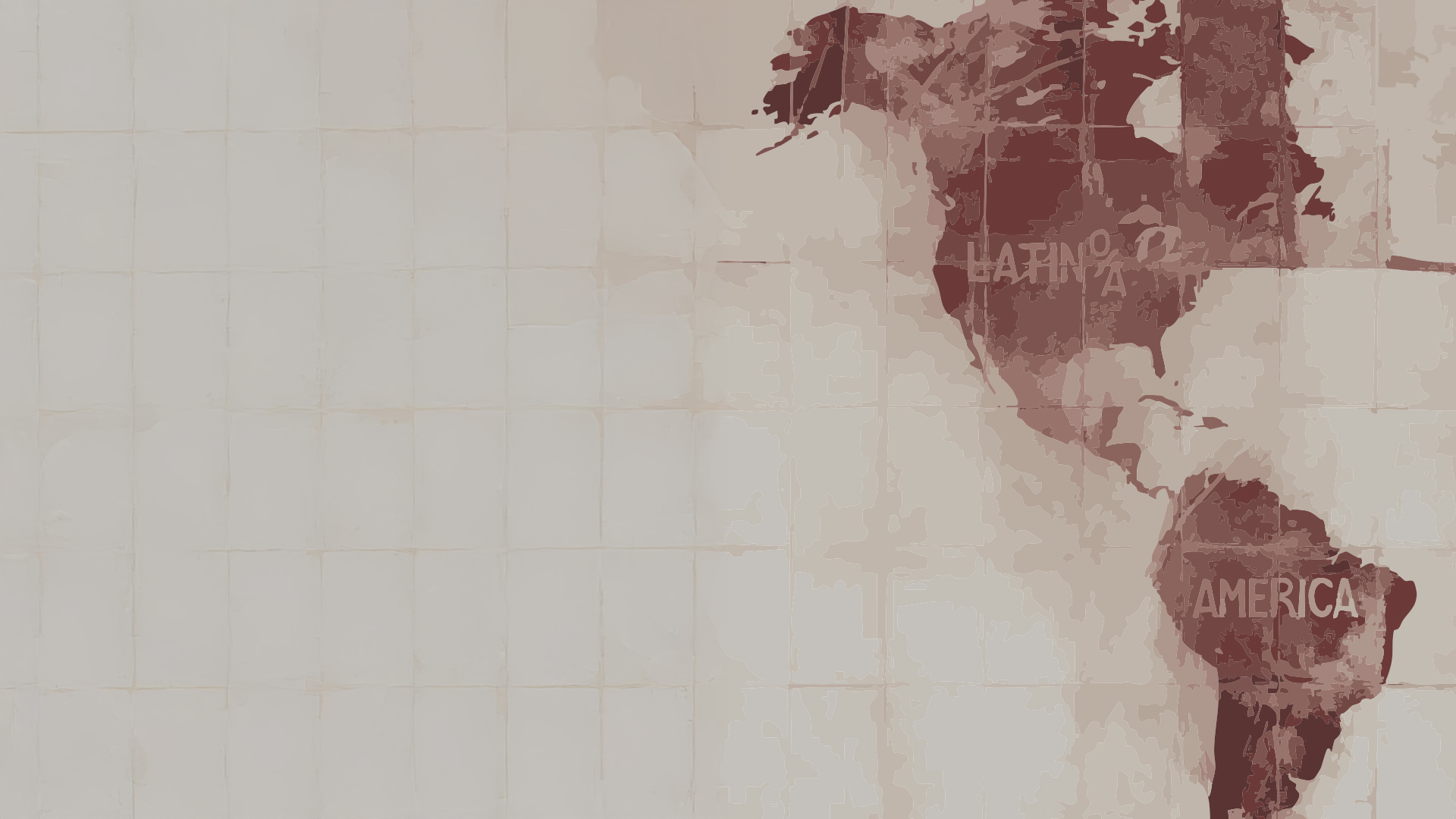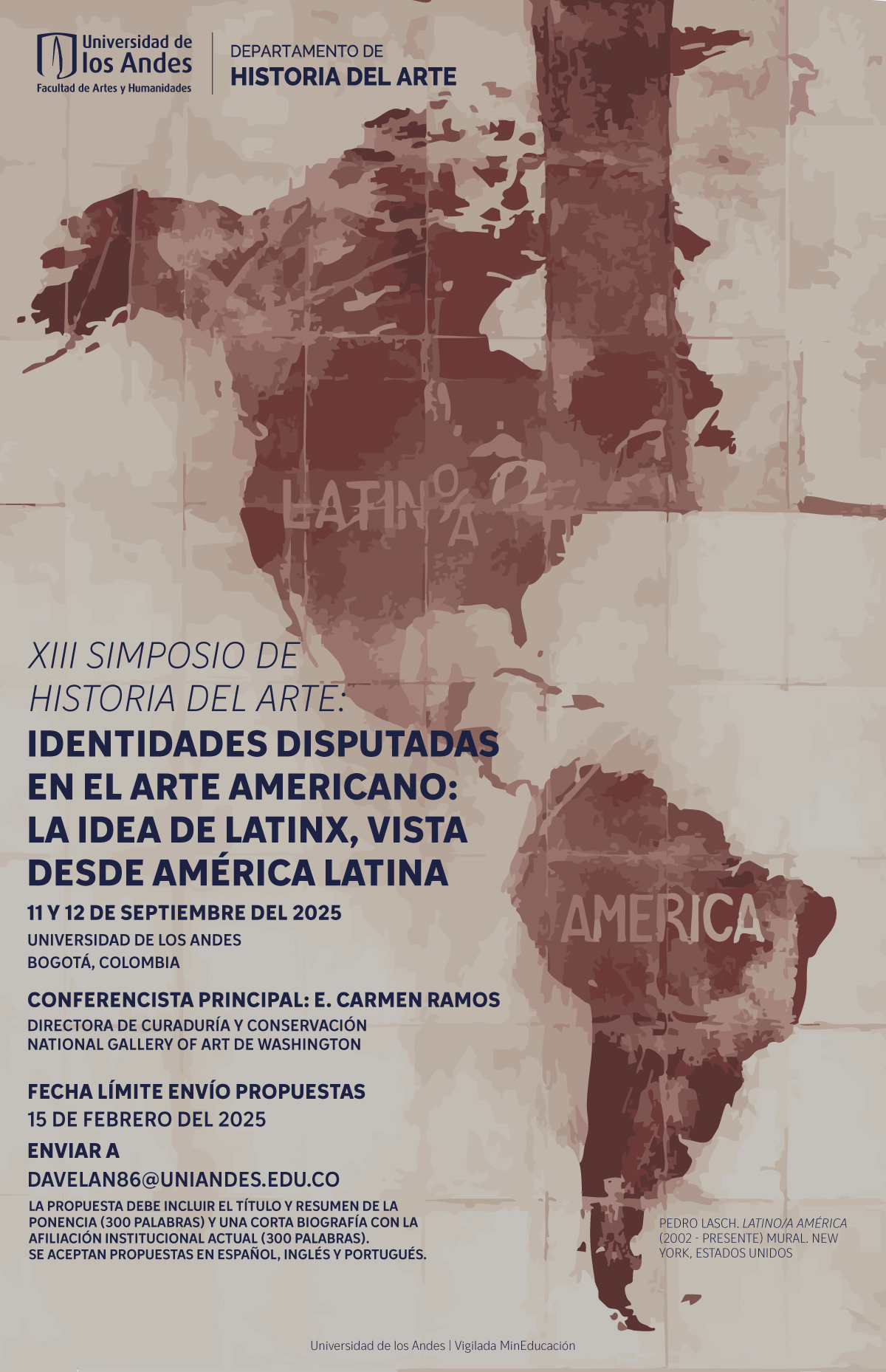
Convocatoria: XIII Simposio de Historia del arte

Convocatoria de ponencias
XIII Simposio de Historia del arte
Identidades disputadas en el arte americano: la idea de Latinx, vista desde América Latina.
Departamento de Historia del Arte, Universidad de Los Andes
Bogotá. 11 y 12 de septiembre de 2025
Fecha límite de envío: febrero 15 de 2025
Conferencista principal: E. Carmen Ramos, directora de curaduría y conservación National Gallery of Art , Washington
En la serie de murales LATINO/A AMÉRICA de Pedro Lasch (2003-), la imagen del continente americano se etiqueta con el término LATINO/A en el hemisferio norte, mientras que el término AMÉRICA aparece en la parte sur. Esta representación desafía las categorías convencionales que suelen usarse para describir tanto el continente como sus divisiones culturales. Al intercambiar las expectativas sobre Latino/a y América como lugares asociados a identidades estables (por ejemplo, Norte vs. Sur), el artista señala que América no se refiere exclusivamente a Estados Unidos y que la cultura Latino/a es una categoría conceptual, no necesariamente vinculada a América Latina como entidad geográfica. Al mismo tiempo, para los latinoamericanos, el término «América» se utiliza principalmente para referirse a todo el continente. De manera similar, el concepto de identidades Latino/a/x surge desde dentro de Estados Unidos, más que desde América Latina.
Una revisión historiográfica muestra que muchas de estas terminologías utilizadas actualmente en el estudio de la historia del arte se originaron en Estados Unidos, en parte debido a su rica historia migratoria. Por ejemplo, según la reciente categoría de Latinx, Pedro Lasch, como artista nacido en México que vive en Estados Unidos desde 1994, sería considerado bajo esta etiqueta, un término que proviene especialmente del mercado del arte.
Asimismo, la noción de América Latina es un constructo del siglo XIX. El término fue utilizado por primera vez por el francés Michel Chevalier en 1836 para contrarrestar el uso de los términos Hispanoamérica, ampliamente utilizados desde la época colonial, y Panamérica, un término promovido tanto por la Doctrina Monroe como por el Destino Manifiesto. Tres objetivos principales guiaron la popularización del término América Latina: primero, la expansión norteamericana buscando influencia sobre las recién independizadas repúblicas del sur; segundo, la posibilidad de una campaña de reconquista desde España; y tercero, la creación de un imperio francés en territorio americano bajo Napoleón III. La noción de latinidad, como explica Arturo Ardao, comenzaba a forjarse y difundirse por el mundo occidental, retomando la historia de la antigua Roma y las civilizaciones del Mediterráneo hasta llegar a la Ilustración francesa. La idea de lo «latino» permitió la continuación de una larga línea de constructos imperiales, aceptados por los intelectuales de élite de América del Sur que emigraron a Europa y adoptaron el término como una estrategia de validación. Un ejemplo de esto es el escritor y diplomático colombiano José María Torres Caicedo, considerado «el padre del latinoamericanismo».
En sus escritos recientes, Arlene Dávila se pregunta si el arte latinoamericano y el arte Latinx son lo mismo. Otros académicos, como Tatiana Flores, han investigado de manera similar el estatus disputado de términos como Latinx, hispano y latinoamericano. ¿Cómo se conectan, o no, los afrodescendientes nacidos en América Latina o con herencia latinoamericana con estas categorías? De manera similar, ¿dónde y cómo encaja el arte caribeño? Podría también cuestionarse otros términos como Iberoamérica y sus aplicaciones. Además, el término Latinx invita a una reflexión sobre la inclusión de género, como señala Adriana Zavala: «La X también insiste en desestructurar el conocimiento para hacer visible esta presencia». En otras palabras, las preguntas sobre la terminología son parte de un debate contemporáneo en curso.
Este simposio invita a reflexiones críticas sobre estas categorías, tal como se aplican dentro de la historia del arte. También abre la puerta a pensar categorías como Latinx desde América Latina, algo que no se ha hecho antes ni se considera usualmente. ¿Qué significa el concepto de Latinx para académicos, artistas y curadores basados en América Latina y el Caribe? Y, de igual forma, ¿cómo reaccionan los académicos del norte al uso del término América como designación continental? Las ponencias pueden abordar otros temas y términos relacionados con debates similares, así como obras de arte que confronten estas categorías, como A Logo for America (1987) de Alfredo Jaar. Por ejemplo, el modo en que se aplica «las Américas» para pensar en el continente de manera plural o la aplicación de América Latina a periodos que ocurrieron antes de que se inventara el concepto, como el arte colonial o prehispánico. También pueden cuestionarse términos como prehispánico y colonial en el contexto de América Latina. En última instancia, este simposio es una invitación a abrir un diálogo y nuevas posibilidades de discusión entre el arte Latinx y el arte latinoamericano.
Otras preguntas que pueden abordar en las ponencias:
- ¿Quién aplica esta terminología? ¿Quién categoriza?
- La definición misma de Latinx.
- ¿Por qué los latinoamericanos ignoran a los artistas Latinx y chicanos?
- ¿Es conveniente un término como Latinx para pensar el pasado artístico antes del siglo XX?
- ¿Cómo es útil comparar Latinx con otros términos como Américas, Hispanoamérica, etc.?
Universidad de los Andes Bogotá, Colombia, 11 y 12 de septiembre del 2025
Bases
La propuesta debe incluir:
- Título y resumen de la ponencia (max. 300 palabras)
- Corta biografía y afiliación institucional (max. 300 palabras)
- El asunto del correo debe decir: “Propuesta Simposio Simposio Historia del Arte 2025”
- Fecha límite para el envío de las propuestas: febrero 15 de 2025
- Envío de propuestas: davelan86@uniandes.edu.co
- Las presentaciones tendrán una duración de 15 minutos.
- Las propuestas serán aceptadas en español, portugués e inglés.
Los autores de las propuestas seleccionadas serán notificados a más tardar el 1 de abril de 2025.
Call for Papers
13th Symposium on Art History
Contested Identities in American Art: The Idea of Latinx, as Seen from Latin America.
Department of Art History, Universidad de Los Andes
Bogotá. September 11-12, 2025
Submission deadline: February 15, 2025
Keynote speaker: E. Carmen Ramos, Director of Curatorial and Conservation, National Gallery of Art, Washington
Contested Identities in American Art: The Idea of Latinx, as Seen from Latin America
In Pedro Lasch’s LATINO/A AMÉRICA mural series (2003–), the image of the American continent is labeled with the term LATINO/A in the northern hemisphere, while the term AMÉRICA appears in the southern portion. This depiction challenges conventional categories typically used to describe both the continent and its cultural divisions. By subverting expectations about the terms Latino/a and América as places associated with fixed identities (e.g., North vs. South), the artist highlights that “America” does not refer exclusively to the United States and that Latino/a culture is a conceptual category, not necessarily tied to Latin America as a geographic entity. Meanwhile, for Latin Americans, the term América is generally used to refer to the entire continent. Similarly, the concept of Latino/a/x identities emerges from within the United States rather than from Latin America.
A historiographic review reveals that many of the terminologies currently used in art history originated within the United States, partly due to its rich history of immigration. For instance, under the relatively new category of Latinx, Pedro Lasch, a Mexican-born artist living in the United States since 1994, would fall under this classification—a term rooted primarily in the art market.
Likewise, the concept of Latin America is a 19th-century construct. The term was first used by Frenchman Michel Chevalier in 1836 to counterbalance terms such as Hispanic America—widely used since colonial times—and Pan America, which was promoted by the Monroe Doctrine and the ideology of Manifest Destiny. Three main objectives drove the adoption of the term Latin America: first, the expansionism of the United States, seeking influence over the newly independent southern republics; second, the possibility of a reconquest by Spain; and third, Napoleon III’s vision of establishing a French empire in the Americas. The notion of latinity, as explained by Arturo Ardao, began to take shape and spread across the Western world, drawing from the legacy of Ancient Rome, Mediterranean civilizations, and the French Enlightenment. The idea of “Latin” facilitated the continuation of a long line of imperial constructs, accepted by elite thinkers from South America who immigrated to Europe and adopted the term as a strategy for validation. A notable example is the Colombian writer and diplomat José María Torres Caicedo, often called “the father of Latin Americanism.”
In her recent writings, Arlene Dávila questions whether Latin American art and Latinx art are one and the same. Similarly, scholars such as Tatiana Flores have examined the contested status of terms like Latinx, Hispanic, and Latin American. How do Afro-descendants born in Latin America, or those with Latin American heritage, engage with or diverge from these categories? Furthermore, where and how does Caribbean art fit within these frameworks? Other terms, such as Iberian America (Iberoamérica), also merit exploration. Additionally, the term Latinx invites a reflection on gender inclusion, as Adriana Zavala notes: “The X also insists on queering structures of knowledge in order to make this presence visible.” In other words, debates over terminology remain central to contemporary discourse.
This symposium invites critical reflections on these categories as they are applied within art history. It also seeks to explore concepts like Latinx from the perspective of Latin America—an approach that has rarely been considered. What does Latinx mean to scholars, artists, and curators based in Latin America and the Caribbean? Conversely, how do scholars in the Global North respond to the use of the term América as a continental designation?
Submissions may also address related topics and works of art that challenge these categories, such as Alfredo Jaar’s A Logo for America (1987). For instance, papers could examine the pluralistic use of the term the Americas to describe the continent, or the retroactive application of Latin America to historical periods predating the term’s invention, such as in colonial or pre-Hispanic art. Even the terms pre-Hispanic and colonial Latin America invite scrutiny. Ultimately, this symposium aims to open dialogue and create new opportunities for discussion between Latinx and Latin American art.
Additional questions that could be addressed in the papers:
- Who defines and applies such terminology?
- How should Latinx itself be defined?
- Why do Latin Americans often overlook Latinx and Chicano artists?
- Is the term Latinx useful for thinking about the artistic past before the 20th century?
- How does comparing Latinx with other terms—such as the Americas, Hispanic America, or Pan America—enhance understanding?
The proposal must include:
Title and abstract of the presentation (max. 300 words)
Short biography and institutional affiliation (max. 300 words)
The subject line must read: “Symposium Proposal Symposium Art History 2025”
Deadline for submitting proposals: February 15, 2025
Submit proposals: davelan86@uniandes.edu.co
Presentations will last 15 minutes.
Proposals will be accepted in Spanish, Portuguese and English.
Authors of selected proposals will be notified no later than April 1, 2025.